The Office of Youth Ministry is pleased to announce the Diocesan Catholic Youth Conference (DCYC) will be February 2-4, 2018, at the Vicksburg Convention Center. The theme for the weekend is “Ablaze.” All ninth through 12th grade youth in the diocese are invited to attend. Parish youth ministry leaders already have registration details. All participants must register through their parishes. Early-bird registration is due by mid-December.
This year’s DCYC will consist of keynote presentations and music by PJ Anderson, Catholic artist. The weekend will also inclusde faith-building games, activities, small group discussions, breakout sessions, Reconciliation, adoration and a closing Mass on Sunday.
Updates
Visit with the Bishop
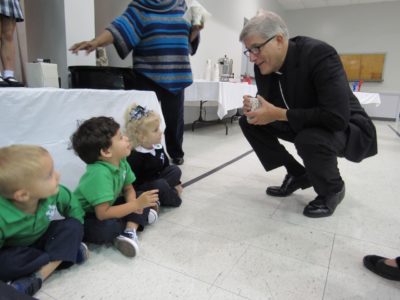
Visit with Bishop Kopacz
MERIDIAN – Bishop Joseph Kopacz talks to St. Patrick School Pre-K3 students John Wilkinson, Eehen Bell and Stella LaCoste after the annual Veterans Mass on Thursday, Nov. 9. Many active and retired military were honored during the service. (Photo by Helen Reynolds)
Report: young people want to lead
By Carol Zimmermann
BALTIMORE (CNS) – Young people in the church want to be heard and be invited to be a part of church leadership, according to a report by the U.S. Conference of Catholic Bishops in preparation for next year’s Synod of Bishops on youth.
They are often at transition points in their lives, yet they don’t know where to go for mentorship, Cardinal Daniel N. DiNardo of Galveston-Houston, USCCB president, said Nov. 13.
He presented a summary of the responses gathered from dioceses and Catholic organizations to the bishops during their annual fall assembly in Baltimore.
The cardinal noted that pulling together the responses of young people from high school age to young adults is a challenge because of the group’s broad diversity and many different needs.
He also said the report affirms a growing awareness of the challenges young people face today with economics, anxiety and drug and alcohol abuse.
The cardinal pointed out that the survey responses indicate that church leaders have work to do to walk with young people and address challenges they face, but he also said there has been some positive growth in young people’s faith, especially for those in high school and college.
We have “talented leaders out there doing incredible things with limited resources,” Cardinal DiNardo said, adding that he is grateful for their enthusiasm and leadership.
The responses gathered by the USCCB will be sent to the Vatican which is gathering survey responses from young Catholics around the world.
The USCCB also is going to send three young adults to the pre-synod gathering next March in Rome. In announcing the meeting, the pope said: “The church wants to listen to the voices, the sensibilities, the faith as well as the doubts and criticisms of young people. We must listen to young people.”
The theme for the Synod of Bishops, which will be held in October 2018, is: “Young people, faith and vocational discernment.”
Young people attending the meeting will represent bishops’ conferences, the Eastern Catholic churches, men and women in consecrated life and seminarians preparing for the priesthood. It will also will include representatives from other Christian communities and other religions and experts in the fields of education, culture, sports and the arts.
(Follow Zimmermann on Twitter: @carolmaczim.)
Veterans honored at Mass at Sacred Heart
SOUTHAVEN – Students and teachers hold their hands up in blessing over veterans during the school’s Veteran’s Day Mass. Father Greg Schill, SCJ, a veteran himself, celebrated the Mass. (Photo by Sister Margaret Sue Brooker)
Annunciation School readers top state again
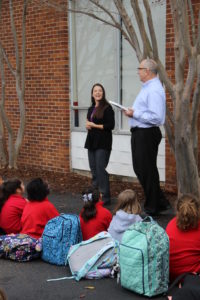 COLUMBUS –Annunciation School students are the Scholastic Summer Reading Challenge champs for the fifth consecutive year. Overall, the school logged 672,794 reading minutes and finished in the top 40 worldwide. Representatives from Scholastic visited the campus on Wednesday, November 8, to present the official award plaque and banner. The school community offered a huge thank you to the librarian, Terri Doumit, seen accepting the award from Scholastic Representative, Les Kevehazi. She coordinates this program every year. (Photo by Katie Fenstermacher)
COLUMBUS –Annunciation School students are the Scholastic Summer Reading Challenge champs for the fifth consecutive year. Overall, the school logged 672,794 reading minutes and finished in the top 40 worldwide. Representatives from Scholastic visited the campus on Wednesday, November 8, to present the official award plaque and banner. The school community offered a huge thank you to the librarian, Terri Doumit, seen accepting the award from Scholastic Representative, Les Kevehazi. She coordinates this program every year. (Photo by Katie Fenstermacher)
Packed house enjoys Journey of Hope
By Maureen Smith
JACKSON – Father Burke Masters headlined the Catholic Charities Journey of Hope meet and greet and luncheon Monday and Tuesday Nov. 6-7.
A few dozen fans turned out Monday night to the Mississippi Sports Hall of Fame for a meet and greet, including a busload of students from Madison St. Joseph High School.
On Tuesday, more than 800 people listened to him speak at the Journey of Hope luncheon at the Jackson Convention Center. Father Masters told the story of his greatest moment of sports, when he hit the home run that propelled the Mississippi State University Bulldogs to the College World Series, and then contrasted it with his actual performance in the series, which was less than stellar. He went on to talk about how his life was truly not complete until he became a priest and began working in vocations to help other people find God’s will for their lives, but he does hold onto his baseball roots as chaplain for the Chicago Cubs.
The Journey of Hope is one of Catholic Charities’ main fundraising events each year. After the lunch, a representative from the organization invites attendees to make a pledge to support the work of Catholic Charities throughout the diocese.
Life of African-American priest told through play ‘From Slave to Priest’
By Joyce Duriga
CHICAGO (CNS) – The life of Father Augustus Tolton already reads like a novel and now it is immortalized on stage with the new play “Tolton: From Slave to Priest,” produced by St. Luke Productions from Battle Ground, Washington.
Tolton, a former slave, is the first recognized American diocesan priest of African descent. The Archdiocese of Chicago opened his cause for sainthood in 2011, giving him the title “servant of God.”
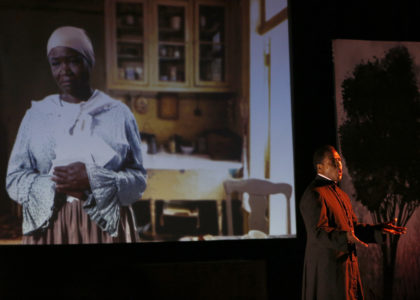
Andrae Goodnight, at right, portrays Father Augustus Tolton in the production “Tolton: From Slave to Priest” at DuSable Museum of African American History in Chicago Nov. 5. (CNS photo/Karen Callaway, Chicago Catholic)
Born into slavery, he fled with his mother and siblings through the woods of northern Missouri and across the Mississippi River while being pursued by soldiers when he was only nine years old. The small family made their home in Quincy, Illinois, a sanctuary for runaway slaves.
The boy’s father had died earlier in St. Louis, after escaping slavery to serve in the Union Army.
Growing up in Quincy and serving at Mass, young Augustus felt a call to the priesthood, but, because of rampant racism, no seminary in the United States would accept him. He headed to Rome, convinced he would become a missionary priest serving in Africa. However, after ordination, he was sent back to his hometown to be a missionary to the community there, again facing rampant racism.
He was such a good preacher that many white Catholics joined his black parishioners in the pews for his Masses. This upset white priests in the town, so Father Tolton headed north to Chicago, at the request of Archbishop Patrick Feehan, to minister to the black Catholic community here.
Father Tolton worked to the point of exhaustion for his congregation in Chicago, and on July 9, 1897, he died of heatstroke while returning from a priests’ retreat. He was 43.
His journey is now crystallized in a 90-minute, one-person play that premiered Nov. 5 at Chicago’s DuSable Museum of African American History. For more than 30 years, St. Luke Productions has produced other plays about holy men and women, including St. Faustina, St. Maximilian Kolbe and St. John Vianney.
Leonardo Defilippis, president and founder of St. Luke Productions, first learned of Father Tolton from a priest in the Diocese of Springfield, which includes the town of Quincy where the priest served and is buried.
Defilippis researched Father Tolton’s life and hung a photo of him in his office. When deciding which play he would produce next, he noticed the photo again and started praying to Father Tolton. Defilippis said he felt the Holy Spirit was asking him to make a play of the priest’s life.
Once decided, the producer reached out to Cardinal Francis E. George, who as Chicago’s archbishop at the time had opened Father Tolton’s cause for canonization during the Year of the Priest. The cardinal directed him to Chicago Auxiliary Bishop Joseph N. Perry, postulator of Father Tolton’s cause. Defilippis said he and his team worked closely with Bishop Perry on the play.
“It’s exciting to do something in complete conjunction with the canonization process. It’s a tool that can be used for this,” he told the Chicago Catholic, the archdiocesan newspaper. “It’s one of the most unique shows right now in theater because it’s a multimedia show, which means you have characters on a screen that are interacting with a live actor.”
Defilippis has created a “very unique art form” that makes it easy for groups anywhere to host the play because of the simple setup.
When writing the script, Defilippis, who co-wrote the play with his wife, pulled from themes in Father Tolton’s life – perseverance, trust in God, incredible forgiveness
and his priesthood.
Defilippis believes the time Father Tolton spent studying for the priesthood in Rome opened him up to the universality of a priest’s ministry. He studied with men from all over the world and saw the church’s history in places like the catacombs, the Coliseum and St. Peter’s Basilica.
“Once he becomes a priest, he’s a priest for all. This is not a segregated situation, it’s not a segregated mindset,” Defilippis said.
The play doesn’t shy away from the harsh realities Father Tolton faced, such as severe prejudice against him from fellow priests in Quincy. The post-Reconstruction period was a troubled time for the United States, and tensions and violence were real. Father Tolton himself often spoke of being watched.
Defilippis believes that telling Father Tolton’s story through art is a way to bring light into today’s seemingly dark world.
“The highest form of art is when you not only entertain and inspire, but bring it to another level, of what we call evangelization of what actually touches hearts in a deep and impactful way that actually changes lives,” he said. “That’s what we’ve seen with these plays.”
Stay tune – this play coming to Jackson.
(Editor’s Note: For more about the play, visit www.stlukeproductions.com. For more about Father Tolton’s canonization process, visit www.toltoncanonization.org.Duriga is editor of the Chicago Catholic, newspaper of the Archdiocese of Chicago.)
Ordinary time offers opportunity in present tense
KNEADING FAITH

Fran Lavelle is the Director of Faith Formation for the Diocese of Jackson
By Fran Lavelle
One of the things that living in the country teaches you to appreciate is daylight. In the summer months long days are a farmer’s greatest asset. My dad used to say, “You’ve got to make hay while the sun shines.” This adage reflects the reality that there is an appropriate time to do everything. It is excellent advice for all of us. It reminds me of the wisdom of Ecclesiastes 3:1, “there is an appointed time for everything, and a time for every affair under the heavens.“
I’m not sure if it is all environmental, but this time of year, as daylight hours are shorter, I find myself thinking about time. What a beautiful season of harvest, honoring the saints, remembering those who have gone before us marked with the sign of faith, and giving thanks for our many blessings. The evenings, once filled with a cacophony of sounds coming from insects, frogs, birds and coyotes have been nearly silenced. If one is lucky they can hear the fading sound of crickets.
Crisp fall air, the harvest moon, the smell of burning wood from home chimneys are all welcome reminders that the long hazy hot days of summer have passed. The call to come inside is not just literal. With shorter days and the time change it is as if God is calling us inside to do the interior work faith requires. Unfortunately, in our culture today we are addicted to busyness. We forget the latter part of that agrarian wisdom, “while the sun shines.” We don’t know how to embrace the darkness, the solitude, the quieted moments of life.
In my pursuit to appreciate “time” in a more significant way I found myself inspecting the events of my life. To my surprise, it was not the big events that I ended up focusing on. Rather, I was looking at the nooks and crannies where ordinary life is lived. I told a friend the other day that I wanted to put more living in my life. I was not exactly sure what I meant by this. After some thought, I realized that it is not that I want a more exciting life, a life of glamor or exotic travel. It occurred to me that I want to be more present to the ordinary. This became clear to me one particularly beautiful fall Saturday a few weeks ago I when was mowing the yard. I felt the warm sun on my skin, a gentle breeze was adrift, the smell of fresh cut grass filled the air and I felt so grateful and so alive. My thoughts were uplifted, my heart was full and I found peace in that moment. How could this ordinary event be the source of so much peace? How could I replicate experiences like this more often?
Every day we experience the ordinary. As a matter of fact, I am fixing dinner and have a load of laundry in the washer as I write this. And, no, I’m not floating on a cloud of fresh linens, rosemary or pumpkin spice anything. But it takes work to see gifts in the ordinary. After all, there is a season for everything. My “making hay” tonight looks a lot more like more like fish sandwiches and clean socks but in being present to the task at hand I am anchored in the now. Perhaps that’s the real lesson in this rumination. Perhaps the real challenge is to find ways to be more present, more intentional to the now, not worrying what is to come or what has passed. I recall sharing with a friend a long litany of what was going on in my life. I was focused on who and what needed my attention in the future. He looked at me and said, “I’m here right now.” He was right. I was so focused on what was to come that I did not see what was right before me.
The church in her wisdom gives us different the seasons of the liturgical year. We follow the life, death and resurrection of Jesus in these seasons. Beautifully mixed between these memorable events of the life of Christ is Ordinary time. The weeks of Ordinary time are nearly over for yet another liturgical year. Our challenge is to recognize that every season, be it in the church, nature, or our own life that we are not stringing along disjointed segments of living. If we are mindful and living in the present we find the depth and riches in all of it. The long days of summer and quieted days of winter, the abundance of life in the spring, and the bountiful harvest in the fall. Yes, even making fish sandwiches and doing a load of laundry. “Life gets mighty precious when there’s less of it to waste…” Bonnie Raitt
(Fran Lavelle is the Director of Faith Formation for the Diocese of Jackson.)
Asking for abundance this Thanksgiving
Complete the circle

George Evans
By George Evans
I presume many of you are enjoying your Thanksgiving leftovers as your paper arrives on Friday or Saturday after the Thursday holiday. What a great secular feast to celebrate with family and friends, particularly those from out of town. Food abounds to the point of excess. Perhaps wine is chosen to help wash down and digest what is eaten.
Patriotism fills the air – pilgrims and Indians and the early days of this special country and the blessings which have seen America grow and prosper perhaps more than any other country in the world.
Because of the traditional atmosphere in America we not only thank family and friends but also the God of our belief. There may be a few less believers than in the past (at least that’s what we are told), but those who know God as their creator and friend experience a very special gratitude at Thanksgiving as they reach for one more piece of turkey or one more spoon of dressing, green bean casserole, baked sweet potato with marshmallow topping, or cranberry just to make it all better.
As we think of how blessed we are because of America’s seemingly special place in the world, the conversation around the table may divert for a while to the problems of hurricanes, floods, power outages, terrorist attacks and inconceivable mass killings. Someone may even ask God to do something about all that and remind us that we have been faithful to providing a great meal to all the homeless folks at Gateway and other soup kitchens and food banks and doubling our contributions to our favorite charities such as St. Vincent de Paul and Catholic Charities or any number of other worthwhile organizations. There may even be a strong supporter of Catholic Relief Services or Bread for the World who chimes in.
About the time pecan pie, apple pie or ice cream is served with coffee, the absolute disaster on the national political scene is broached. After some wailing and gnashing of teeth and some cries for impeachment of Trump or indictment of crooked Hillary, the group decides that’s a little too big for us to solve but it sure needs God’s help even more than hurricanes, floods and terrorists.
We end our secular feast of Thanksgiving by deciding that what we need is more spiritual. We need to ask God’s involvement to increase rather than decrease (more prayer for him to send the Spirit to make each of us better). We need to read the Gospels more receptively and to follow them, even the tough parts about reaching out to the poor, vulnerable and those who are widows, orphans and refugees. Next year maybe we should invite some folks from the highways and byways to dinner with us and see what they can add as St. Luke and Pope Francis suggest.
We love America and our family and friends so much we want to save it. To do so, I think we better embrace the whole world around us by loving as Jesus taught us to love before its too late.
(George Evans is a retired attorney and pastoral minister. He lives in Madison and attends Jackson St. Richard Parish.)
Our Lady of Guadalupe, pray for us: study says devotion may impact immigrants’ health
By Maureen Smith
JACKSON – A good talk with your mother every day could improve your health. At least, that’s what happened for immigrants in one Mississippi community. A study out of the University of Alabama exploring the link between faith and health demonstrated that those with a devotion to Our Lady of Guadalupe had fewer negative health issues related to stress.
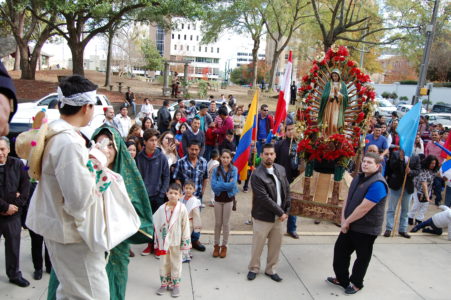
JACKSON– The Hispanic community at the Cathedral of St. Peter the Apostle hosts a procession downtown, like this one from 2016, for the feast of Our Lady of Guadalupe. (Photo by Elsa Baughman)
“This drives home how important faith is. In the study results I found that people who are exposed to stress – their wellbeing goes down over time. Those who were Guadalupan devotees broke that pattern,” explained Rebecca Read-Wahidi, the study’s author.
She grew up in Forest where the state’s largest concentration of Latinos work in poultry plants. They worship at St. Michael or at its mission San Martín. A community of Sisters, Guadalupan Missionaries of the Holy Spirit, ministers to the mix of Mexican, Guatamaulan and other Latin American people. The sisters teach English, host consulates and even offer workshops in what to do if people are stopped by police or immigration agents.
Constant worry about immigration raids can wear down an already poor population. Read-Wahidi was told stories of a 2012 road-block that led to the deportation of 40 people, sending a wave of fear through the rest of the community. Having a patroness, a protector and a surrogate mother helps ease that physical and mental stress.
Our Lady of Guadalupe appeared in 1531 to Juan Diego, a poor Indian and recent Christian convert. She told him she wanted him to go to the bishop and have a church built on Tepeyac Hill. The lowly Juan Diego was turned away. He told the Virgin to send someone else. When his uncle become deathly ill, Juan Diego went in search of a priest instead of returning to the bishop, trying to avoid the Virgin by walking another way around the hill. She appeared anyway, declared that Juan Diego’s uncle was already cured and sent him, again, to the bishop, telling him to take flowers as a sign. She herself tied the flowers into his cloak, or tilma. When Juan Diego unwrapped the cloak, he and the bishop were shocked to find a perfect image of the Virgin on the cloak under the flowers.
In the image, she is dark skinned, pregnant, and surrounded by stars. She stands in front of the sun’s rays, a commonly known symbol of an Aztec god, symbolically eclipsing his power as she looks lovingly down on her people. Millions of pilgrims still flock to Tepeyac to see the tilma.
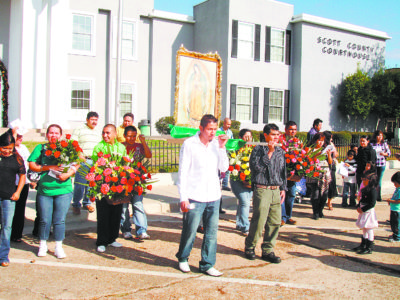
FOREST – This 2012 photo shows a procession honoring Our Lady of Guadalupe from the Scott County Courthouse to St. Michael Parish. Rebecca Read-Wahidi conducted her doctoral research on the link between devotion and health in this community.(Mississippi Catholic file photo)
Read-Wahidi studied at Mississippi State University. Her Spanish studies took her to Mexico where she was exposed to the pervasive devotion to Our Lady of Guadalupe. “While I was there, I became interested in Mexican Catholicism because it was different than what I was familiar with,” she said. When she returned home, she began to see the Virgin in her own hometown.
“It is really fascinating to me because it really is a contrast in Mississippi – which is very Protestant. Here is this Mexican feast being carried out in the streets of a Mississippi town,” she said. Read-Wahidi wrote her master’s thesis about Our Lady of Guadalupe and migrant communities in Mississippi. She expanded upon her earlier thesis while studying for a doctorate in biocultural medical anthropology at the University of Alabama. “I liked going there because I could continue working with the same community,” Read-Wahidi said. “I went from (looking at) the celebration itself into how they use it to deal with stress, specifically immigration stress,” she added.
The sisters in Morton welcomed her, introducing her to the community and facilitating meetings. Read-Wahidi developed a survey to gauge the impact of their faith on their health.
Our Lady of Guadalupe is more than just a mother figure to her people, she is their mother. Read-Wahidi said most of the devotees she interviewed have conversations with her throughout the day. Sister Lourdes Gonzalez, MGSpS, who helped with the study, said Mary “listens to their worries. It’s a way to pray. People talk to her as if she is alive and in the room. She has a special place in the family.”
Father Tim Murphy, pastor at Tupelo St. James Parish calls the relationship profound and inspiring. “She is their mother in faith, in heaven and is present to them,” he said.
This connection to the poor may be why people see Mary as the perfect intersessor. “They may not feel comfortable talking to God – but they can speak to the Virgin. She is the mother figure. When they are so far from home, they need a mother figure,” Read-Wahidi said.
Father Michael McAndrew, CsSR, has been working in Hispanic ministry for many years and gives presentations on Juan Diego’s experience. “When Juan Diego does not want to go to the bishop, Mary tells him ‘am I not here? Am I not your mother? Would your mother not protect you on your journey? I am with you.’”
Read-Wahidi wrote in a journal article that immigrants place their stress in Mary’s hands. “When I asked what people petition the Virgin to help them with, they mentioned: finding work and keeping their jobs, not getting deported or arrested, the health of their family back in Mexico and here in the United States, the safety of family members who were making the journey across the border, and their own safe return back home.”
These prayers offer relief from the stress of their everyday lives. “They are seen as outsiders. They are not equal (here). They have the experience of racism, It is a way to remind themselves that in the eyes of the Virgin, all people are equal,” said Read-Wahidi. This idea has spread to other immigrants through public celebrations surrounding the feast.
Every year on or around the Dec. 12 feast day, immigrants across Mississippi leave the safety of their homes and churches to take their mother to the streets and celebrate her love and protection. Celebrations include processions, hours-long traditional Aztec dances, meals and liturgy. Everyone, especially other immigrants are welcome. In this way, the celebration in America is unique. Instead of being only a Mexican feast, it is a feast for all. “They make the celebration public – it is taken out into the streets. It gives the Mexican community a chance to share her (the Virgin). They enjoy seeing other people embrace her,” explained Read-Wahidi.
“We make processions because we know as a people we are walking in life, we are on a journey – we are walking to heaven, to God,” said Sister Gonzalez.
The celebrations are a sharp contrast to daily life for immigrants. They spend most of their lives trying to avoid attention. But for the feast, they come out in droves. Father Murphy said 300 people attended one procession in northeast Mississippi. “They will come straight from the fields. This will be the end of the sweet potato harvest so they will come with the dust still on them, but they will come and celebrate,” said Father Murphy.
“The best of liturgy does not represent, it re-presents the truth,” said Father Murphy. “This celebration is good liturgy. Who does (Our Lady of) Guadalupe appear to? The lowest of the low,” he said. Asking Mary to intercede offers a powerful conduit to Jesus since, in Our Lady of Guadalupe, “the mother of our savior is the mother of the poor.”
(See page 13 for a schedule of celebrations for this year.)
